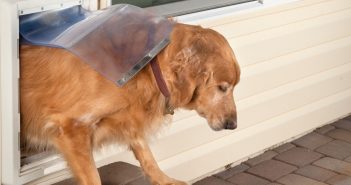Our dogs love bones and my hubs and I fight over whether or not it’s okay to give our dogs various types of bones. Veterinarian Dr. David Brooks offers up this fun advice as to whether it’s safe to give your dog a bone . . .
It’s true, dogs love bones. They don’t much care what kind of creature the bone came from, nor are most dogs terribly picayunish about the relative freshness and state of hygiene. It’s a BONE.
With a nick-nack, paddywack,
Give a dog a bone;
This old man came rolling home.
~Old English nursery rhyme
Not to belabor the obvious, but dogs do love bones. Whether it’s a fresh, raw, meaty one (RMB) or a properly aged specimen stealthily buried and then unearthed – either by the dog that originally stashed it or by a lucky (or observant) treasure robbing rover – it’s a precious commodity to most any canine; something worth fighting over. Stolen bones appear to carry the most value.
And yet we hear so many conflicting opinions presented as hard and fast facts, often vehemently, by well-meaning dog lovers.
“Dogs must have bones in their diet or their teeth will rot.”
“Dogs must never have bones because the bones will cause obstructions in the bowels/splinter and puncture internal organs/cause internal bleeding.”
There are two keys to the dilemma: one, ONLY raw bones, never boiled, baked, roasted, broiled, smoked or otherwise cooked; and, two, use common sense, watch your dog gnawing bones and be familiar with whether your dog safely chews them or if he breaks off pieces and bolts them down. Part of common sense is also presenting bones of appropriate size and density to your dog. You wouldn’t want to give a Bullmastiff bones so small he would be prone to wolfing them down without chewing and conversely you wouldn’t give a Yorkie a bovine joint – “never eat anything bigger than your head” is a good rule of thumb for small dogs.
Common advice has been to warn dog owners of ever allowing their friends to partake of poultry skeletons, and that is partially true. Never, ever, ever should your pet have access to that leftover chicken, turkey, duck, goose, Cornish game hen, quail, squab – you get the idea – COOKED carcass. Poultry bones can be a valuable part of a dog’s diet, if common sense is followed rather than common advice. Raw, bone-in cuts of poultry are beneficial to most dogs, not only are the bones rich in nutrients just like any other type of bones, especially the marrow; the connective cartilage is a raw source of glucosamine, an amine found to be beneficial to the support of healthy joints.
Another guideline to use is to present your dog with bones from non-weight bearing parts of a carcass. Weight-bearing bones, especially in large animals, are much denser and can conceivably cause chipped teeth, particularly if given to smaller dogs or older dogs whose teeth are beginning to age. As you familiarize yourself with your dog’s bone chewing habits you will be able to fine tune your choices.
People often avoid pork RMBs, usually for reasons that have no application to the canine diet. Pork can be a valuable addition to a dog’s nutritional spectrum and most dogs do enjoy it immensely. Like anything else, common sense is the key. It is a good idea to freeze any raw meat before giving it to your pet. Freezing kills parasites and other nasty little surprises that might be lurking without changing the basic structure of the bone and making it dangerously brittle and prone to splintering like heat
does.
Oh, and back to the nursery rhyme . . . “Nick” is British slang for jail, and back in the day, the term “paddywack” was a derogatory reference to an angry, unruly person – specifically a “brawny Irishman.”
The term “Paddy” (from Padraic/Patrick) was commonly applied by the British to the Irish and found its way into common usage, even following Irish immigrants across the ocean to America in the nineteenth and twentieth centuries where it stuck in commonly used slang like “paddywagon,” the vehicle used to cart criminals off to jail. Now, whether paddywagons were referred to as such because so many Irish immigrants became policemen or because so many paddywacks found themselves being hauled off to the nick in the back of one . . . I’ll leave that up to you to decide.
In the meantime, the next time you come rolling home from the grocery store or butcher (or from a successful hunt), give that dog a bone!!





4 Comments
I have a boxer and he is so funny with bones. He will spit it out onto the ground and come back to it when nobody is looking. What a little character.
it also strengthens their teeth and gums
I really enjoyed this article. I am glad to see the part of chicken bones. This was excellent to see as most anyone I have ever spoken with feels chicken bones are bad for dogs. I am going to link to this article in my blog. Very fine job!
.-= The Pet Blog´s last blog ..Forming A Bond With Your Parrot =-.
Great Post!
Dog Gates